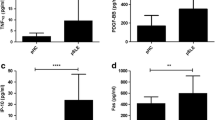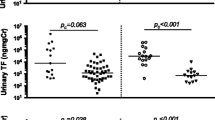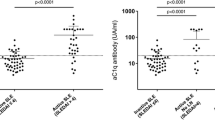Abstract
Childhood systemic lupus erythematosus (SLE) is known to have a worse prognosis than adult-onset disease, and monitoring and treatment of the disease are still a challenge. Thus, there is an urgent need for highly reliable, non-invasive biomarkers for early detection of relapses, to avoid long-term complications and to optimize the management of children with LN. Recent studies of pediatric patients have yielded novel specific biomarkers for SLE diagnosis which can be used for monitoring disease activity and response to treatment. The most promising biomarkers in juvenile-onset SLE include cell-bound complement activation products, some genomic profiles, and urinary proteins such as neutrophil gelatinase-associated lipocalin, monocyte chemoattractant protein-1, and alpha-1-acid glycoprotein. None of these might be suitable for use as a single SLE-biomarker. More likely a combination of novel biomarkers with traditionally used data, including autoantibodies and complement, might help to enhance sensitivity and specificity for early diagnosis, disease monitoring, and prediction of relapses.cp
Similar content being viewed by others
References
Papers of particular interest, published recently, have been highlighted as: • Of importance
Midgley A, Beresford MW. Cellular localization of nuclear antigen during neutrophil apoptosis: mechanisms for autoantigen exposure? Lupus. 2011;20(6):641–6.
Pan Y, Sawalha AH. Epigenetic regulation and the pathogenesis of systemic lupus erythematodes. Transl Res. 2009;153(1):4–10.
Ahearn JM, Liu CC, Kao AH, et al. Biomarkers for systemic lupus erythematosus. Transl Res. 2012;159:326–42.
Cook HT, Botto M. Mechanisms of disease: the complement system and the pathogenesis of systemic lupus erythematodes. Nat Clin Prac Rheumatol. 2006;2(6):330–7.
Watson L, Beresford MW. Urine biomarkers in juvenile-onset SLE nephritis. Published online Pediatr Nephrol. 2012; doi:10.1007/s00467-012-2184-y
Hochberg MC. Updating the American College of Rheumatology revised criteria for the classification of systemic lupus erythematosus. Arthritis Rheum. 1997;40(9):1725.
Hersh AO, Trupin L, Yazdany J, et al. Childhood-onset disease as a predictor of mortality in an adult cohort of patients with systemic lupus erythematodes. Arthritis Care Res. 2012;62(8):1152–9.
Liu CC, Ahearn JM. The search for lupus biomarkers. Best Pract Res Clin Rheumatol. 2009;23:507–23.
Liang MH, Socher SA, Larson MG, et al. Reliability and validity of six systems for the clinical assessment of disease activity in systemic lupus erythemotodes. Arthritis Rheum. 1989;32(9):1107–18.
Faurschou M, Starklint H, Halberg P, et al. Prognostic factors in lupus nephritis: diagnostic and therapeutic delay increases the risk of terminal renal failure. J Rheumatol. 2006;33(8):1563–9.
Chun HY, Chung JW, Kim HA, et al. Cytokine IL6 and IL10 as biomarkers in systemic lupus erythematosus. J Clin Immunol. 2007;27:461–6.
Illei GG, Tackey E, Lapteva L, et al. Biomarkers in systemic lupus erythematosus. I. General overview of biomarkers and their applicability. Arthritis Rheum. 2004;50(6):1709–20.
Rahman A, Isenberg DA. Systemic lupus erythematodes. N Engl J Med. 2008;358(9):929–39.
Ching KH, Burbelo PD, Tipton C, et al. Two major autoantibody clusters in systemic lupus erythematosus. Plosone. 2012;7(2):1–11.
Jurencak R, Fritzler M, Tyrrell P, et al. Autoantibodies in pediatric systemic lupus erythematosus: ethic grouping, cluster analysis, and clinical correlations. J Rheumatol. 2009;36:416–21.
Simon JA, Cabiedes J, Ortiz E, et al. Anti-nucleosome antibodies in patients with systemic lupus erythematosus of recent onset. Potential utility as a diagnostic tool and disease activity marker. Rheumatology. 2004;43:220–4.
Malleson PN, Sailer M, Mackinnon MJ. Usefulness of antinuclear antibody testing to screen for rheumatic disease. Arch Dis Child. 1997;77:299–304.
McGhee JL, Kickingbird LM, Jarvis JN. Clinical utility of antinuclear antibody tests in children. BMC Pediatr. 2004;4:13.
Jesus AA, Silva CA, Carneiro-Sampaio M, et al. Anti-C1q antibodies in juvenile-onset systemic lupus erythematodes. Ann N Y Acad Sci. 2009;1173:235–8.
Mok CC. Biomarkers for lupus nephritis: a critical appraisal. J Biomed Biotechnol. 2010;638413:1–13.
• Liu CC, Manzi S, Kao AH, et al. Cell-bound complement biomarkers for SLE: from benchtop to bedside. Rheum Dis Clin North Am. 2010;36(1):161–72. Liu et al. summarized studies performed on different cell-bound complement activation proteins. Significant results showed that those cell-bound complement components may perform more reliably than soluble complements proteins as biomarkers for SLE.
Porcel JM, Ordo J, Castro-Salomo A, et al. The value of complement activation products in the assessment of systemic lupus erythematosus flares. Clin Immunol Immunopathol. 1995;74:2883–8.
Kasitanon N, Magder LS, Petri M. Predictors of survival in systemic lupus erythematodes. Medicine (Baltimore). 2006;85(3):147–56.
Welch TR, Blystone LW. Renal disease associated with inherited disorders of the complement system. Pediatr Nephrol. 2009;24(8):149–1444.
Manzi S, Navratil JS, Ruffing MJ. Measurements of erythrocyte C4d and complement receptor 1 in the diagnosis of systemic lupus erythematodes. Arthritis Rheum. 2004;50(11):3596–604.
Navratil JS, Manzi S, Kao AH. Platlet C4d is highly specific for systemic lupus erythematosus. Arthritis Rheum. 2006;54(2):670–4.
Liu CC, Kao AH, Hawkins DM, et al. Lymphocyte-bound complement activation products as biomarkers for diagnosis of systemic lupus erythematosus. Clin Transl Sci. 2009;2(4):300–8.
Yang DH, Chang DM, Lai JH, et al. Usefulness of erythrocyte-bound C4d as a biomarker to predict disease activity in patients with systemic lupus erythematosus. Rheumatology. 2009;48:1083–7.
Arce E, Jacksan DG, Gill MA, et al. Increased frequency of pre-germinal center B cells and plasma cell precursors in the blood of children with systemic Lupus Erythematosus. J Immunol. 2001;167:2361–9.
Folzenlogen D, Hofer MF, Leung DY, et al. Analysis of CD80 and CD86 expression on peripheral blood B lymphocytes reveals increased expression of CD86 in lupus patients. Clin Immunol Immunopathol. 1997;83:199–204.
Jacobi AM, Reiter K, Mackay M, et al. Activated Memory B Cell Subsets Correlate With Disease Activity in Systemic Lupus Erythematosus. Delineation by Expression of CD27, IgD, and CD95. Arthritis & Rheumatology 2008; 58(6):1762–1773
Bijl M, Horst G, Limburg PC, et al. Expression of costimulatory molecules on peripheral blood lymphocytes of patients with systemic lupus erythematosus. Ann Rheum Dis. 2001;60:523–6.
Zhang J, Roschke V, Baker KP, et al. Cutting edge: a role for B lymphocyte stimulator in systemic lupus erythematosus. J Immunol. 2001;166:6–10.
Villard JF, Bloch-Michel C, Neau-Cransac M, et al. HLA-DR expression on lymphocyte subsets as a marker of disease activity in patients with systemic lupus erythematosus. Clin Exp Immunol. 2001;125:485–91.
Dai Z, Turtle CJ, Booth GC, et al. Normally occurring NKG2D+ CD4+ T cells are immunosuppressive and inversely correlated with disease activity in juvenile onset lupus. J Exp Med. 2009;206(4):793–805.
Nath SK, Kilpatrick J, Harley JB. Genetics of human systemic lupus erythematodes: the emerging picture. Curr Opin Immunol. 2004;16(6):794–800.
Sestak AL, Nath SK, Sawalha AH. Current status of lupus genetics. Arthritis Res Ther. 2007;9(3):2010.
Yang Y, Chang EK, Zhou B. The intricate role of complement component C4 in human systemic lupus erythematodes. Curr Dir Autoimmun. 2004;7:98–113.
Al-Mayouf SM, Abanomi H, Eldali A. Impact of C1q deficiency on the severity and outcome of childhood systemic lupus erythematosus. Int J Rheum Dis. 2011;14(1):81–5.
Nikpour M, Dempsey AA, Urowitz MB, et al. Association of a gene expression profile from whole blood with disease activity in systemic lupus erythematosus. Ann Rheum Dis. 2008;67:1069–75.
Kozyrev SV, Alarcon-Riquelme ME. The genetics and biology of Irf5-mediated signalling in lupus. Autoimmunity. 2007;40(8):591–601.
Kyogoku C, Langefeld CD, Ortmann WA. Genetic association of the R620W polymorphism of protein tyrosine phosphatase PtPn22 with human SLE. Am J Hum Genet. 2004;75(3):504–7.
Firestein GS. Kelley’s textbook of rheumatology. Philadelphia: Elsevier WB Saunders; 2008. p. 1270.
Marini R, Costallat LT. Young age at onset, renal involvement, and arterial hypertension are of adverse prognostic significance in juvenile systemic lupus erythematodes. Rev Rheum Engl Ed. 1999;6(6):303–9.
Zabaleta-Lanz ME, Munoz LE, Tapanes FJ, et al. Further description of early clinically silent lupus nephritis. Lupus. 2006;15(12):845–51.
Mak A, Mok CC, Chu WP, et al. Renal damage in systemic lupus erythematodes: a comparative analysis of different age groups. Lupus. 2007;16(1):28–34.
Weening JJ, D'Agati VD, Schwartz MM, et al. The classification of glomerulonephritis in systemic lupus erithematous revisited. J Am Soc Nephrol. 2004;15:241–50.
Hiraki LT, Lu B, Alexander SR, et al. Endstage renal disease due to lupus nephritis among children in the US, 1995–2006. Arthritis Rheum. 2011;63(7):1988–97.
Watson L, Midgley A, Pilkington C, et al. Urinary monocyte chemoattractant protein 1 and alpha 1 acid glycoprotein as biomarkers of renal disease activity in juvenile-onset systemic lupus erythematosus. Lupus. 2012;21:496–501.
Fine DM, Ziegenbein M, Petri M, et al. A prospective study of protein excretion using short-interval timed urine collections in patients with lupus nephritis. Kidney Int. 2009;76(12):1284–8.
Ayodele OE, Okpechi IG, Swanepoel CR. Predictors of poor renal outcome in patients with biopsy-proven lupus nephritis. Nephrology. 2010;15(4):482–90.
Schwartz N, Michaelson JS, Putterman C. Lipocalin-2, TWEAK, and other cytokines as urinary biomarkers for lupus nephritis. Ann N Y Acad Sci. 2007;1109:265–74.
Gwira JA, Wei F, Ishibe S, et al. Expression of neutrophil gelatinase-associated lipocalin regulates epithelial morphogenesis in vitro. J Biol Chem. 2005;280(9):7875–82.
Brunner HI, Mueller M, Rutherford C, et al. Urinary neutrophil gelatinase–associated lipocalin as a biomarker of nephritis in childhood-onset systemic lupus erythematosus. Arthritis Rheumatol. 2006;54(8):2577–84.
Hinze CH, Suzuki M, Klein-Gitelman M, et al. Neutrophil Gelatinase-associated Lipocalin is a predictor of the course of global and renal childhood-onset systemic lupus erythematosus disease activity. Arthritis Rheum. 2009;60:2772–81.
• Brunner HI, Bennett MR, Mina R, et al. Association of noninvasively measured renal protein biomarkers with histologic features of lupus nephritis. Arthritis Rheumatol. 2012;64(8):2687–97. Brunner et al. investigated urine samples of 76 patients for novel urinary biomarkers, established markers of renal function, and compared these with histologic features of LN. Different increases in levels of specific biomarkers reflecting histological features seen in either active or chronic LN could be observed. This study showed that a combination of urinary markers together with established markers could serve as a biomarker panel.
Rovin BH, Birmingham DJ, Nagaraja HN, et al. Biomarker discovery in human SLE nephritis. Bulletin of the NYU Hospital of Joint Diseases. 2007;65(3):187–93.
Rubinstein T, Pitashny M, Levine B, et al. Urinary neutrophil gelatinase-associated lipocalin as a novel biomarker for disease activity in lupus nephritis. Rheumatology. 2010;49(5):960–71.
Hinze CH, Suzuki M, Klein-Gitelman M, et al. Neutrophil Gelatinase-associated Lipocalin anticipates the Course of Global and Renal Childhood-Onset Systemic Lupus Erythematosus Disease Activity. Arthritis Rheum. 2009;60(9):2772–81.
Marks SD, Williams SJ, Tullus K, et al. Glomerular expression of monocyte chemoattractant protein-1 is predictive of poor renal prognosis in pediatric lupus nephritis. Nephrol Dial Transpl. 2008;23:3521–6.
Marks SD, Shah V, Pilkington C, et al. Urinary monocyte chemoattractant protein-1 correlates with disease activity in lupus nephritis. Pediatr Nephrol. 2012;25:2283–22889.
Hammad AM, Youssef HM, El-Arman MM. Transforming growth factor beta 1 in children with systemic lupus erythematosus: a possible relation with clinical presentation of lupus nephritis. Lupus. 2006;15:608–12.
Marks SD, Shah V, Pilkington C, et al. Renal tubular dysfunction in children with systemic lupus erythematosus. Pediatr Nephrol. 2005;20:141–8.
Suzuki M, Wiers K, Brooks EB, et al. Initial validation of a novel biomarker panel for active pediatric lupus nephritis. Pediatr Res. 2009;65:530–6.
Suzuki M, Ross GF, Wiers K, et al. Identification of urinary proteomics signature for lupus nephritis in children. Pediatr Nephrol. 2007;22:2047–57.
Chaussabel D, Quinn C, Shen J, et al. A modular analysis framework for blood genomics studies: application to systemic lupus erythematosus. Immunity. 2008;29(1):150–64.
Brunner HI, Huggins J, Klein-Gitelman MS. Pediatric SLE – towards a comprehensive management plan. Nat Rev Rheumatol. 2011;7(4):225–33.
Disclosure
No potential conflicts of interest relevant to this article were reported.
Author information
Authors and Affiliations
Corresponding author
Additional information
This article is part of the Topical Collection on Pediatric Rheumatology
Rights and permissions
About this article
Cite this article
Binder, E., Edelbauer, M. Use of Biomarkers in the Management of Children with Lupus. Curr Rheumatol Rep 15, 312 (2013). https://doi.org/10.1007/s11926-012-0312-0
Published:
DOI: https://doi.org/10.1007/s11926-012-0312-0




